While shopping online, ~80% of customers read online reviews or comments on products and services before any purchase. However, some of these reviews can be fraudulent as promoting certain products or depreciating them and, as a result, misguide buyers. Indeed, 2.700,000 fake reviews were detected in 2021, which makes up ~50% of consumer reviews with five star ratings.1
Explore how fake reviews are created, AI or machine learning methods used to detect deceptive consumer reviews, fake review detection, and real-life applications for identifying them:
How are fake reviews generated?
Figure 1. Comparison of a fake review with a review by a real user
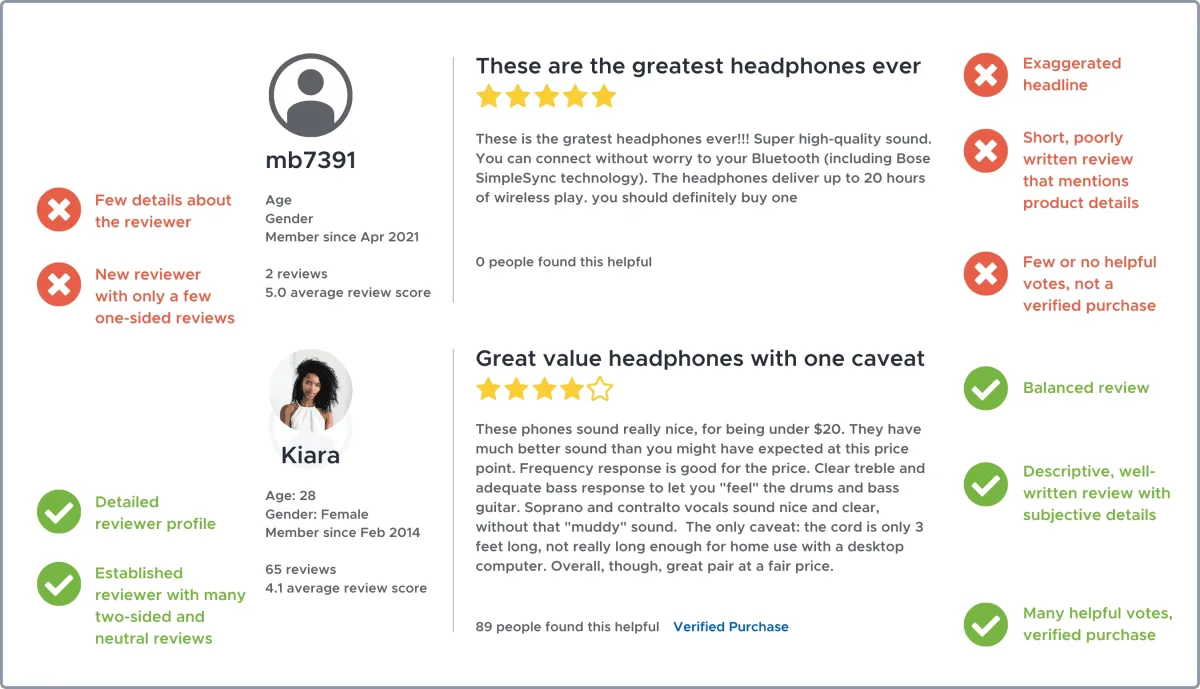
Source: ReviewTrackers2
Fake reviews are mainly written in two ways: human-generated and machine-generated.
Human-generated fake reviews
Content creators get paid to create fake online reviews, and they promote or depreciate certain products in their reviews. In general, there exist three patterns:
- The owner of the products can pay content creators to write feedback to obtain higher ratings or impress potential customers.
- Or, competitors may hire spammers to demonize the products of other brands and try to direct customers to alternatives, in that case, their products.
Machine-generated fake reviews
User generated content is time-consuming, labor-intensive, and costly when it is done manually. Therefore, automated algorithms (e.g., Natural Language Processing (NLP) and Machine Learning (ML) methods) are applied to create fake reviews. Contrary to human-generated reviews, machine-generated reviews are produced through text generation, which can generate reviews on a large scale.
With the advance of generative AI tools such as ChatGPT, companies can also generate fake reviews writing related prompts (see figure below). Unfortunately, this poses challenge to detecting fake reviews as the examples below resemble real person sentences.
Figure 2. Example of fake reviews generated by ChatGPT-4.

Watch how fake reviews on Google can affect local businesses.
Fake review detection methods
Manual detection
It is the most basic way of detecting fake reviews, and annotators manually decide whether a review is fake. Although it can be a promising approach, research shows that humans have 57% accuracy in a fake review detection task.3 Besides, as there is an exponential increase in online reviews, it requires a great workforce and time.
Sponsored
Clickworker has more than 5 million users globally and assists businesses in collecting survey data, feedback from customers, and market research. With the assistance of their international network, which is headquartered in more than 160 countries, they provide their customers platform for conducting surveys and targeted survey respondents.
If interested, here is our data-driven list of survey participant recruitment services and survey tools.
Algorithm-based detection
The number of online reviews on TripAdvisor has increased from 200 million to 1 billion from 2014 to 2021.4 As customers’ reviews increase exponentially, so do fake reviews. Machine learning techniques provide a solution to detect online spam. ML algorithms analyze the texts based on
- Textual (e.g., nouns, phrases, punctuation, linguistic style) features
- Behavioral (e.g., number of reviews, review dates, user profile) features
Then, algorithms make classifications based on these features. Recent research applying the -means algorithm, an ML method, achieves 96% accuracy in detecting fake reviews.5
Algorithms can be trained to detect fake reviews through textual features such as
- Excessive punctuation use
- Poor grammar
- An overly negative or positive tone
You can utilize generative AI tools to help in fake review detection. To do this effectively, first, provide the algorithm examples of fake reviews along with explanations focusing on the cues that might indicate being fake. Then, you can present a set of reviews and ask the algorithm to identify which ones might be fake.
Researchers use sentiment analysis methods to identify fake reviews based on textual features. Sentiment analysis identifies opinions or feelings in texts as containing positive, negative, or neutral tones.
For those interested, here is our data-driven list of sentiment analysis services.
Algorithms can also monitor the behavioral pattern of reviewers, such as the user’s total number of reviews, review dates, and user profile details. These metrics allow ML models to classify suspicious reviews and help determine fake review characteristics.
You can also check our article on fraud detection.
Case studies of fake review detection
1- Sentiment analysis on Amazon reviews
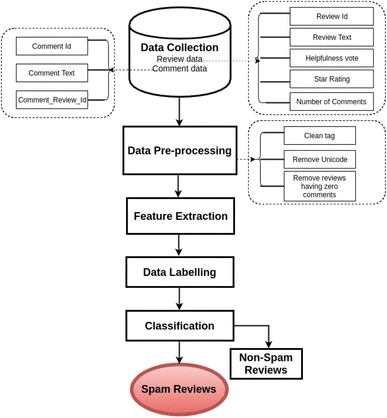
Source: CSI Transactions on ICT 6
Figure 4. Flow diagram of the study on fake review detection through sentiment analysis
Researchers collected ~40,000 reviews through web scrapers from the Amazon website and conducted sentiment analysis, classifying texts based on their sentiment score as positive, negative, or neutral. Then they determined a sentiment threshold to detect suspicious reviews and applied Random Forest classification based on the scores obtained. Their results showed 91% accuracy in detecting fake reviews.7
2- Feature engineering on Yelp Restaurant and Hotel reviews
Researchers conduct feature engineering to the processed data using ML techniques based on two datasets: Yelp Restaurant and Hotel online reviews. They compared various ML models on these datasets and found that logistic regression performs better than the other algorithms, providing 88% accuracy in detecting fake reviews.8
3- Classification of fake reviews on the App Store
Researchers used the Apple App Store dataset containing 22+ million reviews from 1.4 million apps to detect fake reviews. Results show that ~66 million (35% of all reviews) were fake.9 Among those, 60,000 were written by a single spammer.
Real-life applications of how companies fight against fake reviews
Yelp fake reviews consumer alert
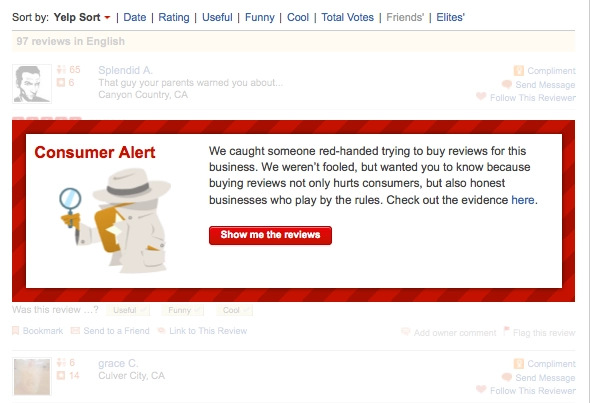
Source: Yelp Blog10
Figure 5. Example of a fake review alert on Yelp
Yelp detects that some sellers buy fake reviews. After detecting fake review buyers, Yelp warns potential customers about their fraudulent actions. They aim to shame sellers that buy online spammers to write positive reviews for their brands.
Amazon files back suit for those buying fake reviews on Facebook
Amazon has 12,000+ employees working on fraud or abuse, and they discovered 10,000 Facebook groups in 2022 created to buy fake reviews in exchange for money or free products.11 The company announced that it had taken proactive legal action to remove the groups and find the bad actors.
Further Reading
- Ad Fraud: What Is It, How It Works, & How to Combat It?
- The Ultimate Guide to Avoiding CAPTCHAs in Web Scraping
- Generative AI Ethics: Top 6 Concerns
Don’t hesitate to contact us if you have any questions:
External Links
- 1. Global online fake reviews removed by star rating 2021| Statista. Statista
- 2. How to Spot Fake Reviews: 6 Easy Steps | ReviewTrackers. ReviewTrackers
- 3. ScienceDirect.
- 4. Tripadvisor: number of reviews 2024| Statista. Statista
- 5. ScienceDirect.
- 6. Detection of spam reviews: a sentiment analysis approach | CSI Transactions on ICT . Springer India
- 7. Detection of spam reviews: a sentiment analysis approach | CSI Transactions on ICT . Springer India
- 8. A Supervised Machine Learning Approach for the Credibility Assessment of User-Generated Content | Wireless Personal Communications . Springer US
- 9. Towards understanding and detecting fake reviews in app stores | Empirical Software Engineering . Springer US
- 10. How Yelp Protects Consumers From Fake Reviews | Yelp - Official Blog. Yelp - Official Blog
- 11. How Amazon spots fake reviews | About Amazon. US About Amazon
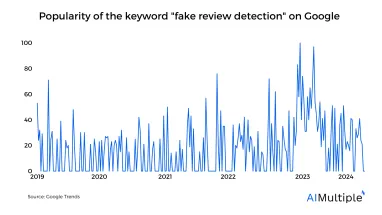
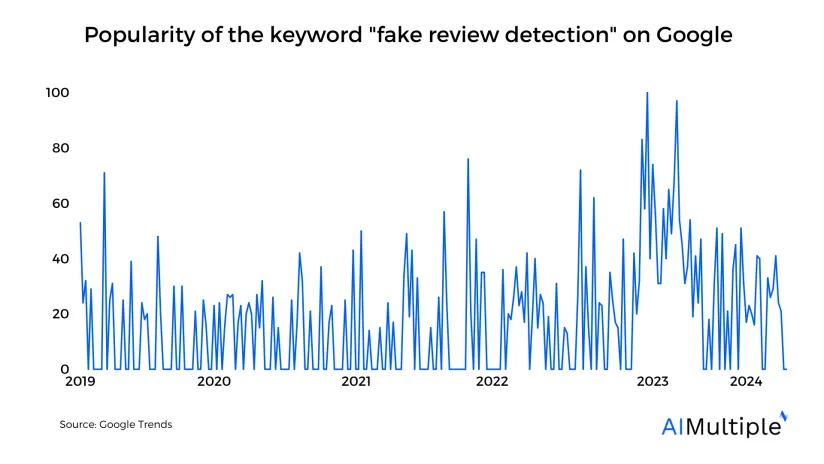


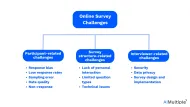
Comments
Your email address will not be published. All fields are required.